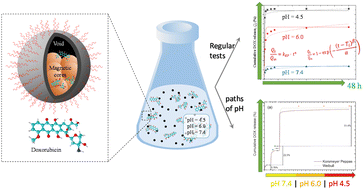Doxorubicin delivery performance of superparamagnetic carbon multi-core shell nanoparticles: pH dependence, stability and kinetic insight†
Abstract
In the past decade, magnetic nanoparticles (MNPs) have been among the most attractive nanomaterials used in different fields, such as environmental and biomedical applications. The possibility of designing nanoparticles with different functionalities allows for advancing the biomedical applications of these materials. Additionally, the magnetic characteristics of the nanoparticles enable the use of magnetic fields to drive the nanoparticles to the desired sites of delivery. In this context, the development of new MNPs in new approaches for drug delivery systems (DDSs) for cancer treatment has increased. However, the synthesis of nanoparticles with high colloidal stability triggered drug delivery, and good biocompatibility remains a challenge. Herein, multi-core shell MNPs functionalized with Pluronic ® F-127 were prepared and thoroughly characterized as drug carriers for doxorubicin delivery. The functionalized nanoparticles have an average size of 17.71 ± 4.2 nm, high water colloidal stability, and superparamagnetic behavior. In addition, the nanoparticles were able to load 936 μg of DOX per mg of functionalized nanomaterial. Drug release studies at different pH values evidenced a pH-triggered DOX release effect. An increase of 62% in cumulative drug release was observed at pH simulating tumor endosome/lysosome microenvironments (pH 4.5) compared to physiological conditions (pH 7.4). In addition, an innovative dynamic drug delivery study was performed as a function of pH. The results from this test confirmed the pH-induced doxorubicin release capability of carbon multi-core shell MNPs. The validity of traditional kinetic models to fit dynamic pH-dependent drug release was also studied for predictive purposes.



 Please wait while we load your content...
Please wait while we load your content...